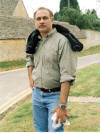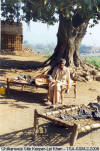|
|
the-south-asian.com July / August 2006 |
|
|||
|
August/September Contents
Sufis - wisdom against 50
years of mountain Heritage cities:
Cotton - the fibre of
|
|
||||
|
Page
1 of 2 BHERA - the town that time forgot Part II By Salman Minhas
The Road to Bhera : Bhera can best be reached by the Motorway M2 from Lahore to Islamabad / Rawalpindi. Going north, just before the river Jhelum is the midway Bhera Motorway stop and collection of CNG and Petrol stations restaurants and the Interchange sign at Bhera. Once on the Interchange road to Bhera, one comes to a fork in the road after 3 kilometers. The right one leads into Bhera via the Sher Shah Suri mosque [circa 1540] and into the ChakWala Gate from where the main Bazaar with its shops of Henna, Phenian [vermicelli], Tobacco, Brown Sugar- Gur starts. If one takes the left fork on the Interchange one comes in front of a small fruit and vegetable market, in front of the Laloowala [ Chinioti Gate ].
Just before Mandi Bahauddin, one takes the Sugar Mill road on the right . Malakwaal about 20 kilometers is on the railway line to Bhera and Khewra the great salt mines center is reached after crossing the Jhelum river at Malakwaal . Next is the village of Miani [home also to a few big Havelis / Mohallas] about another 10 kilometers and finally Bhera another 5 kilometers. The Bhera railway station stands in a great yard with huge Peepal and Bohar trees. Its engine turning circular steel platform is now out of use. The Bhera Government High school is next on the road. On the right is an old solitary temple. While taking pictures of this temple, a white peacock [known as a vain bird ] walked out of the side hut and proceeded to do a fashion catwalk, whose results are presented here.
|
|||||
|
Copyright © 2000 - 2006 [the-south-asian.com]. Intellectual Property. All rights reserved. |
|||||






